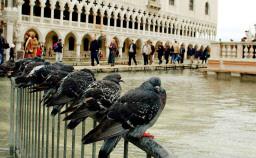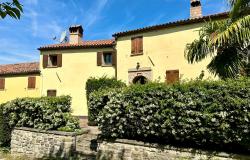Venice is setting its sights on its pesky pigeons again after new reports showed the risks the birds pose to its health and heritage.
''We must do more to get rid of these troublesome animals,'' local councillor Alberto Mazzonetto told ANSA.
Mazzonetto, a member of the regionalist Northern League, said his party would ask local magistrates to take action on the health risks linked to the birds.
Among the reports unveiled on Tuesday, he noted, was one from the local public health research body ULSS which ''spoke openly about the risk of contracting serious diseases from the birds''.
''The ULSS has raised a clear alarm, calling for targeted action which would even include danger alerts for local inhabitants and tourists''. Local health inspector Sergio Lafisca highlighted the risks of contracting lung diseases and salmonella from the birds - a risk that is higher for children and the elderly.
''In Piazza San Marco you see people, especially kids.
literally covered by pigeons. They also fly right over the piazza's tables, showering germs on the food,'' Lafisca said.
The ULSS report highlighted the ''extremely elevated concentration'' of pigeons in the historic square, due to the presence of feed stalls.
Therefore, it is there that ''the birds enter into direct and prolonged contact with human beings, something which immeasurably multiplies the risk factors''.
As well a number of diseases, the pigeons carry ticks and nits, the report highlighted.
Another report focused on the damage pigeons do to the city's cultural heritage.
''The birds produce about a million tonnes of droppings a day, causing serious damage to monuments,'' it said.
The data, put together by the ULSS and Venice's art superintendency, focused on the different ways the birds endanger the city's historic beauty.
''First and foremost, the sheer weight of thousands of birds is a risk to delicate buildings,'' the report said.
The pigeons scratch monuments with their claws and peck at stone in order to get the calcium they need to digest their food.
But it is their droppings which cause the most harm.
''The guano, with its high acidic content, dissolves stone by penetrating into microscopic fissures. When it solidifies, it drops off, taking with it fragments of stone which, although tiny, have a significant impact over time given the quantity of birds involved''.
According to the science faculty at Venice University, pigeon droppings also attract sulphur-based bacteria that attack marble, as well as lichen and funghi that eat away at it. Venice has for years been trying to cut its pigeon population. The last stand-off is taking place in St Mark's Square, where many tourists see the flocking birds as part of the famed location's appeal.
The bird-seed vendors have appealed to the courts which have upheld their rights to their traditional turf.
The traders have also insisted that, if they be forced to move on, they should be handed concessions to sell toys and souvenirs in other parts of the lagoon city.
But officials are optimistic that a deal can be made.
''We're prepared to pay what it takes to get the vendors out of the piazza,'' said Green Councillor Beppe Caccia, who has set a deadline of April 30 for a solution to the problem.
''Compensation will be calculated on the basis of how long the vendor, or vendor's family, has been there and how much their business is worth,'' he said.
''Offers will be full and fair, and I'm confident that the vendors will take them''.
Vendors in St Mark's Square expressed renewed anguish on Tuesday.
''It's absurd to take away our jobs like this. We have to live,'' said Sergio, one of the 20 or so Venetians who run the small stands selling bird seed and corn.
Like several other European cities, Venice has already banned people from feeding pigeons in all other parts of town.
Some experts even claim the excrement, by eroding flagstones, has increased the risk of the 'acqua alta' that puts the square under water for much of the winter.
Local people became more sympathetic to the cause after a report by the Nomisma research group found that the presence of pigeons in Venice costs each resident some 275 euros a year to clean up the mess and damage.













